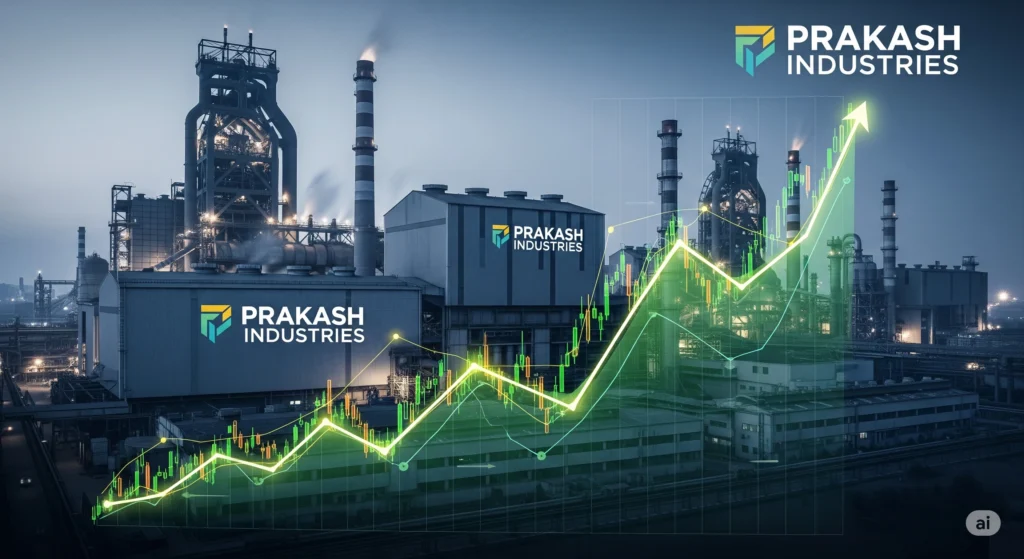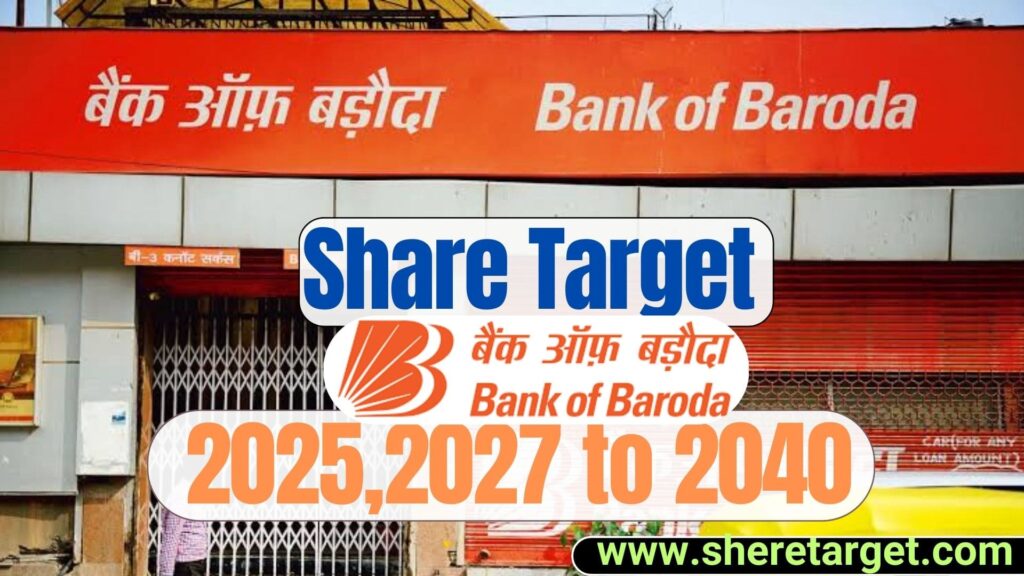The Prakash Industries Share Price Target 2030 is projected by most analysts to be in the range of ₹585–₹587, driven by strong profit growth, low debt, and improving operational efficiency. Conservative models, however, forecast around ₹323 by 2030, highlighting the impact of steel demand, commodity prices, and sector trends on the company’s future performance.
Generated by AI based on market data and expert forecasts. This is not financial advice.
Prakash Industries Share Price Target 2030 makes investing in shares both exciting and daunting, especially for newcomers. With the Indian equity market buzzing and industrial stocks in focus, Prakash Industries Ltd. (PRAKASH) has garnered attention for its consistent performance and growth trajectory in the steel manufacturing and power sector. If you’re evaluating whether Prakash Industries share is the right addition to your portfolio, this comprehensive guide covers every angle you need to know—from performance and valuations to expert forecasts, competitor analysis, and future price targets. Ask ChatGPT
Table of Contents
- Prakash Industries Share Overview
- Fundamental Analysis Of Prakash Industries Share
- Year-on-Year Performance: A Multi-Year Review
- Prakash Industries Share Price Targets (2025–2030)
- Is Prakash Industries Share a Good Buy in 2025?
- Factors Influencing Prakash Industries Share Price
- Key Competitors
- Expert Forecasts and Market Sentiment
- Conclusion
- FAQs
Prakash Industries Share Overview
Prakash Industries Ltd. is a prominent name in India’s steel and power sectors. As of August 2025, the share trades at ₹175–₹182 on Indian exchanges, with a 52-week high of ₹237 and a low of ₹132.5. The company is a BSE SmallCap and NSE-listed, with a market capitalization around ₹3,170 crore.
| Metric | Value |
|---|---|
| Current Price | ₹175–₹182 |
| 52-Week High / Low | ₹237 / ₹132.5 |
| Market Cap | ₹3,170 Cr |
| Dividend Yield | 0.85% |
| Book Value per Share | ₹154.02 |
| PE Ratio | 8.9 |
| ROE (FY25) | 10.7% |
| ROCE (FY25) | 11.3% |
| Debt-Equity Ratio | 0.13 |
Fundamental Analysis of Prakash Industries Share
Strengths
- Trading close to book value: At 0.96x book value, the stock remains attractively valued.
- Consistent profit growth: 24.6% CAGR profit growth over the last five years.
- Low leverage: Debt-to-equity ratio stands at just 0.13.
- Improving returns: ROE and ROCE have trended upward, with current FY25 values at 10.7% and 11.3% respectively.
- Sustained cash flows and manageable expenditure (details below).
Weaknesses
- Modest sales growth: Only 6% CAGR in sales in the last five years.
- Low average ROE over a decade, though it’s improving now.
- Cyclical sector risk: As a metal/steel business, it moves with global commodity cycles and domestic infrastructure demand.
Performance Review: Last Few Years at a Glance
| Year (ending March) | Net Sales (₹Cr) | Net Profit (₹Cr) | Operating Profit (₹Cr) | EPS (₹) | Book Value (₹) |
|---|---|---|---|---|---|
| 2021 | 3,216 | 95 | 315 | 5.32 | 2,720 |
| 2022 | 3,929 | 169 | 391 | 9.42 | 2,633 |
| 2023 | 3,444 | 190 | 413 | 10.64 | 2,775 |
| 2024 | 3,678 | 348 | 493 | 19.44 | 2,845 |
| 2025 | 4,014 | 355 | 520 | 19.85 | 3,140 |
Growth Metrics
- Profit Growth (5-Year CAGR): 24.6%
- Sales Growth (5-Year CAGR): 6%
- ROE (FY25): 10.7%, improved from 6.45% in FY23
- ROCE (FY25): 11.3%, up from 8–9% in FY23
| Ratio | FY21 | FY22 | FY23 | FY24 | FY25 |
|---|---|---|---|---|---|
| ROE (%) | 5.3 | 9.4 | 10.6 | 11.5 | 10.7 |
| ROCE (%) | 5 | 7 | 8 | 11 | 11.3 |
| OPM (%) | 10 | 10 | 12 | 13 | 13 |
| Debt/Equity (x) | 0.14 | 0.13 | 0.12 | 0.13 | 0.13 |
Expenditure, Cash Flow, and Assets
- Total Expenditure (FY24): ₹3,031 crore
- Total Assets (FY25): ₹4,485 crore
- Net Cash Flow: Positive net cash flow of ₹18 crore in FY25 despite industry headwinds (fluctuates YoY)
| Year | Total Expenditure (₹Cr) | Total Assets (₹Cr) | Net Cash Flow (₹Cr) |
|---|---|---|---|
| FY23 | 3,185 | 4,251 | -6 |
| FY24 | 3,031 | 4,059 | 2 |
| FY25 | 3,495 | 4,485 | 18 |
Prakash Industries Share Price Targets: 2025–2030
Forecasts and consensus estimates from leading analysts and algorithmic models for each year:
| Year | Share Price Target Range (₹) | Source/Model |
|---|---|---|
| 2025 | 224–231 | Chart/Fibonacci |
| 2026 | 278–320 | Analyst consensus/models |
| 2027 | 375–410 | Analyst estimates |
| 2028 | 440–502 | Technical projections |
| 2029 | 565–576 | Algorithms |
| 2030 | 585–587 | Chart/Prediction |
| 2030 | 322 (conservative model) | WalletInvestor |
- Official Prediction (Most sources): ₹585–587 by 2030
- Alternative Model: More conservative at ₹323 by 2030
Is Prakash Industries Share Good to Buy in 2025?
Positives for New Investors
- Attractive valuations—low P/E and close to book value.
- Steady profit growth with improving operational metrics.
- Deleveraged balance sheet, minimal debt concerns.
- Reasonable dividend yield and improving efficiency.
- Upside potential with favorable price targets up to 2030.
Key Concerns
- Cyclical sector: Sensitive to global steel price volatility and economic cycles.
- Moderate sales growth relative to profit growth, indicating margin expansion may be plateauing.
- Potential risks from commodity prices, energy costs, and government policies on mining and steel.
Verdict: For risk-tolerant, medium to long-term investors, Prakash Industries can be a portfolio addition with potential upside—contingent on continuing operational efficiency and sector growth.
Factors Influencing Prakash Industries Share Price
- Steel Demand: Domestic infrastructure and construction demand drive revenues.
- Commodity Prices: Input costs (iron ore, coal, power) and global steel prices impact margins.
- Regulatory Policies: Mining licenses, pollution rules, and government projects.
- Operational Efficiency: Improvements in ROE/ROCE signal better capital allocation.
- Debt Profile: Low debt enhances stability in downturns.
- Competition: Aggressive growth or pricing by peers can impact market share.
Key Competitors
Prakash Industries competes with several large and mid-sized players in the Indian steel and power sector, including:
| Company | Market Cap (₹Cr) | P/E | ROE (%) | 2025 Sales Growth (%) |
|---|---|---|---|---|
| Tata Steel | 233,000 | 10.6 | 13.4 | 11 |
| JSW Steel | 209,000 | 12.2 | 14.2 | 15 |
| Jindal Steel & Power | 114,000 | 8.2 | 13.9 | 12 |
| SAIL | 61,000 | 5.6 | 8.8 | 8 |
| Prakash Industries | 3,170 | 8.9 | 10.7 | 9 |
These numbers are for comparative illustration and are rounded averages from industry sources as of August 2025.
Expert Forecasts on the Future of Prakash Industries Share
Most expert forecasts for Prakash Industries are neutral to positive, with targets suggesting significant upside by 2030 if sector momentum continues. Technical analysts point to the breakout potential above ₹210–₹230 as key resistance points on the way to future highs.
Bull Case Scenario
- Sustained steel demand due to Indian infrastructure growth and government’s capital spending.
- Stable input costs and continued operational improvements push margins higher.
- Global steel prices recover after any macro dips.
- Price could exceed ₹600 by 2030, beating conservative models.
Bear Case Scenario
- Prolonged commodity downturn reduces profitability.
- Rising costs, weak export demand, or domestic policy friction hits growth.
- Stock stagnates below ₹250–₹300, lagging sector leaders.
Conclusion
Prakash Industries stands out for its profitability turnaround, low leverage, and improving market sentiment. Conservative price targets predict a twofold rise by 2030, while optimistic models offer even higher returns. For newcomers seeking a steel sector play with reasonable risk and upside, PRAKASH offers a blend of value, growth, and sectoral exposure—though monitoring cyclical risks is crucial.
FAQs
Q1: What is the share price target of Prakash Industries for 2030?
A: Most forecasts point to a target of around ₹585–₹587, with conservative models predicting close to ₹323.
Q2: Is Prakash Industries share good for beginners?
A: Yes, provided you are comfortable with the cyclical nature of the steel market and are investing for the long term.
Q3: How has the company performed financially?
A: Strong profit CAGR of 24%+ over five years, moderate sales growth, and improving ROE and ROCE.
Q4: What are the biggest risks?
A: Industry cycles, input cost volatility, and regulatory changes.
Q5: Who are the main competitors?
A: Tata Steel, JSW Steel, Jindal Steel & Power, and SAIL are major peers.
Steps to Invest in Prakash Industries Shares
- Open a Demat and Trading Account: Choose a registered broker (e.g., Zerodha, ICICI Direct).
- Complete KYC Formalities: Submit your PAN, Aadhaar, and proof of address.
- Fund Your Account: Transfer funds to the trading account using bank UPI/net banking.
- Search for ‘PRAKASH’ on NSE/BSE: Check real-time price and fundamentals.
- Place Your Order: Decide your buy price, enter quantity, and hit ‘Buy.’
- Monitor Portfolio: Regularly track company performance and sector news.
What You Need to Remember
- Stay updated: Track company quarterly results and industry news.
- Diversification: Don’t put all your money into one sector or stock.
- Long-term focus: Sector volatility is normal; invest with a 5–10 year horizon.
Disclaimer: The above article provides a data-driven, expert view as of August 2025. All investments carry risk. Consult your financial advisor before acting on stock recommendations.



